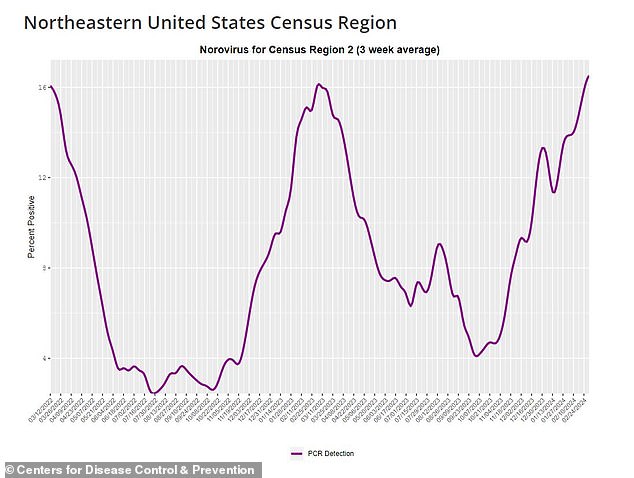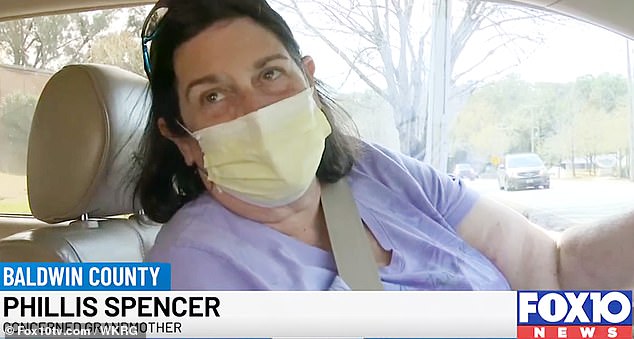Stomach virus that causes severe diarrhea continues to ravage the northeastern US – with one in SIX tests coming back positive
A stomach virus that causes severe diarrhea and vomiting is still prevalent across the country, especially in the Northeast, health officials have announced.
The latest CDC data update shows that 16.5 percent of tests given to hospitalized patients in the Northeast in early March were positive for norovirus — nearly a three percent increase from a month earlier.
This is an increase from just four percent in November, when the outbreak began.
Cases are also rising in the rest of the US, with 15 percent of swabs now detecting the virus, up from nine percent in November.
Norovirus is the most common foodborne illness in the US, affecting approximately 21 million people annually

This graph from the CDC shows how the number of cases has risen to 16.5 percent in recent weeks
Positive tests are rising fastest in the South, by almost 10 percent in just four months.
Approximately 21 million Americans – six percent of the population – become ill from norovirus every year. Of these, about 109,000 are hospitalized and 900 die.
Cases normally peak around February and March, among other ailments, as cold weather forces people to spend more time indoors.
The latest data from the CDC, updated March 7, showed that the test positivity rate — the share of swabs done at hospitals that come back positive for the virus — in the week of March 2 in the Northeast was 16.5 percent was.
A month earlier that was still 13.8 percent.
Cases are also increasing in other regions. In the south, 12.6 percent of tests were positive on March 2, compared to nine percent a month earlier. At the start of the outbreak in November, the positivity rate was only four percent.
Last month, Fairhope West Elementary School in Alabama was forced to close after nearly 800 children and half of the school staff called in sick with a mysterious stomach flu.

Fairhope West Elementary (pictured) closed for a few days last month for deep cleaning as officials try to control the outbreak

Phillis Spencer, who has grandchildren at the school, said the situation was “very alarming”.
State officials said they were investigating the outbreak but believe it is most likely caused by norovirus.
A nearby school, Fairhope East Elementary, has also said it is recording a surge in norovirus cases – with its principal saying she is “monitoring the situation.”
Diego Moreno, whose son attends Fairhope West Elementary and is entering sixth grade — or 12 years old — told reporters he had to take his son to the hospital.
‘Yesterday our son vomited four or five times a night, all night long.
“And today we go to the hospital – and they told us that a lot of children are sick right now.”
So does Philis Spencer, whose grandchildren are in school told reporters: ‘(This is) very alarming, very alarming.
“I’ve never experienced this in all the years I’ve had my own children and grandchildren, so… very alarming.”
She was also filmed wearing a face mask as she rushed to the school to pick up the youngsters.
The Midwest region reported a positivity rate of 13.4 percent on March 2, up from 10 percent a month earlier.
And in the West, 12.8 percent of tests were positive for norovirus as of March 2, compared to 11 percent in early February and five percent in November.
Data from September to early February this year shows that Minnesota and Wisconsin were the hardest hit by norovirus – with both reporting more than five outbreaks during this period.
They are followed by California, Florida, Ohio and Virginia, all of which have reported four outbreaks so far.
But experts say cases are now also starting to skyrocket in states in the Northeast — including New York, Pennsylvania and New Jersey.
Norovirus spreads easily through contact with contaminated surfaces and then by touching the area around the mouth or nose.
Infections usually cause gastrointestinal complaints, such as abdominal pain and watery diarrhea, but also fever and headache.
Excessive vomiting and diarrhea can also lead to dehydration, leading to decreased urination, dry mouth and throat, and dizziness when standing.
In the vast majority of cases, symptoms resolve within two days, requiring little treatment other than bed rest.
The CDC recommends washing your hands with soap and water for at least 20 seconds, especially after using the toilet, after changing a diaper, before handling food, and before giving yourself or anyone else medication.
“It is important to continue washing your hands often, even after you feel better,” the agency states.
“Norovirus can be found in your vomit or stool before you start feeling sick.”
‘The virus can also stay in your poop for two weeks or more after you feel better, and during that time you can still spread norovirus.’
